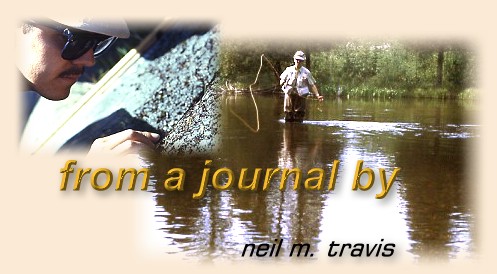Streamside Companions
The Dragonfly
By Neil M. Travis, Montana
When I was a boy my mother called these insects the devil's
darning needle, and she said that they could sew your mouth
shut. I think she just wished that were true! I have also
heard them called mosquito hawks which is a more apt
description. Dragonflies belong to the order Odonata which
is comprised of two suborders: Anisoptera - true dragonflies
and Zygoptera - damselflies. While there are many differences
between the two insects, the most visible difference in the
adult insect is the way they hold their wings when resting.
Dragonflies hold their wings horizontally outward and
damselflies hold them folded parallel over their thorax.
The nymph stage of dragonflies, like the damselflies, is
aquatic. Dragonfly nymphs or naiads are grotesque creatures
with robust or elongated bodies. The color varies with the
species and with the environment, but most are somber-colored.
To aid in camouflage they may be covered with a dense growth
of filamentous algae and debris. They are common in lakes
and streams, and can be found in beds of submerged vegetation
and on the bottom hidden among the detritus.
The naiad is quite an interesting creature. The labium, or
lower lip of the naiad, has been modified for use as a food
capturing device. It is very long, sometimes nearly one-fourth
the length of the body. Normally it lies folded backward
underneath the head and thorax. The front end of this
structure is equipped with stout teeth. The naiad lies
in ambush among the weeds or hidden on the bottom. When
an unsuspecting victim, like a mayfly nymph, stonefly
nymph or even a small fish, comes within range the labium
shoots out and seizes it. The strong teeth hold the prey
firmly and the labium retracts, pulling the prey into range
of the mouth.
The naiads have one other interesting characteristic: they
are jet propelled. The gills, unlike the gills of damselfly
naiads and mayflies, are internal; that is, they are inside
the abdominal cavity. Powerful muscles in the abdomen suck
in water, push it past the gills, and expel it out the anus.
When threatened or when in a hurry to move from one location
to another, they can use this method to propel themselves
forward. Some of the larger naiads can move quite a distance
using this method.
Depending on the species, there is a wide range of size both
in the naiads and in the adults. Mature nymphs of the more
common species range between 15 and 45 mm. in length. Large
adult dragonflies have a wing-span of four inches and a body
length, from head to tail, of three inches.
Dragonfly adults are quite varied in color and size. They have
four wings that are either transparent or banded with darker
bands of color. Body colors range from bright red to dark blue,
with many variations. Some are even banded.
In the northern states dragonflies only live one year. Unlike
damselflies, the naiads do not hatch all at once, but singly
over a period of days or even weeks in early summer. The naiads
crawl out of the water on a reed, rock or any other object that
projects out of the water. It secures itself with its powerful
legs, the skin splits down the back, and the winged adult emerges.
Barring any unforeseen accident, the adult insect may live until
fall. Some of the larger dragonflies migrate, like monarch
butterflies, but most live out their lives within a short
distance of where they emerged.
Dragonflies, especially the larger species, are territorial.
It is possible to find them in the same area, even resting
on the same spot, for the entire season. They defend these
territories from other dragonflies.
Dragonflies are carnivorous, capturing and eating a variety
of insects while on the wing. They have two large compound
eyes that comprise most of the head. The head also contains
a pair of extremely sharp teeth that are used for devouring
their prey. The larger species can deliver a nasty bite to
those inquisitive enough to pick it up.
The dragonfly is another creature that shares our lakes and
streams with us, and makes angling such a fascinating and
rewarding sport. ~ Neil M. Travis, Montana
From A Journal Archives
|

